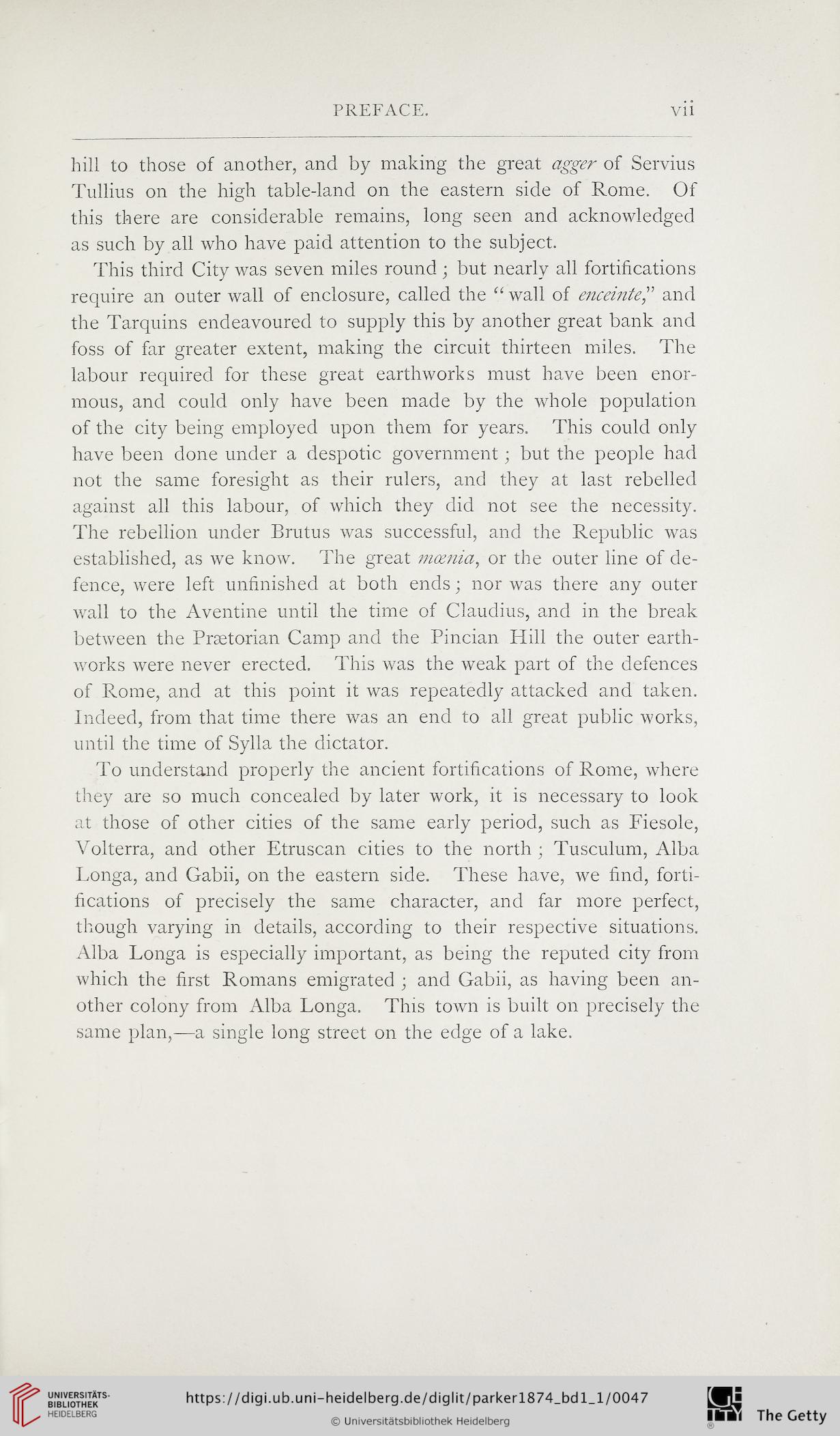PREFACE.
vii
hill to those of another, and by making the great agger of Servius
Tullius on the high table-land on the eastern side of Rome. Of
this there are considerable remains, long seen and acknowledged
as such by all who have paid attention to the subject.
This third City was seven miles round ; but nearly all fortifications
require an outer wall of enclosure, called the “ wall of enceinte',' and
the Tarquins endeavoured to supply this by another great bank and
foss of far greater extent, making the circuit thirteen miles. The
labour required for these great earthworks must have been enor-
mous, and could only have been made by the whole population
of the city being employed upon them for years. This could only
have been done under a despotic government; but the people had
not the same foresight as their rulers, and they at last rebelled
against all this labour, of which they did not see the necessity.
The rebellion under Brutus was successful, and the Republic was
established, as we know. The great moenia, or the outer line of de-
fence, were left unfinished at both ends; nor was there any outer
wall to the Aventine until the time of Claudius, and in the break
between the Prsetorian Camp and the Pincian Hill the outer earth-
works were never erected. This was the weak part of the defences
of Rome, and at this point it was repeatedly attacked and taken.
Indeed, from that time there was an end to all great public works,
until the time of Sylla the dictator.
To understand properly the ancient fortifications of Rome, where
they are so much concealed by later work, it is necessary to look
at those of other cities of the same early period, such as Fiesole,
Volterra, and other Etruscan cities to the north ; Tusculum, Alba
Longa, and Gabii, on the eastern side. These have, we find, forti-
fications of precisely the same character, and far more perfect,
though varying in details, according to their respective situations.
Alba Longa is especially important, as being the reputed city from
which the first Romans emigrated ; and Gabii, as having been an-
other colony from Alba Longa. This town is built on precisely the
same plan,—a single long street on the edge of a lake.
vii
hill to those of another, and by making the great agger of Servius
Tullius on the high table-land on the eastern side of Rome. Of
this there are considerable remains, long seen and acknowledged
as such by all who have paid attention to the subject.
This third City was seven miles round ; but nearly all fortifications
require an outer wall of enclosure, called the “ wall of enceinte',' and
the Tarquins endeavoured to supply this by another great bank and
foss of far greater extent, making the circuit thirteen miles. The
labour required for these great earthworks must have been enor-
mous, and could only have been made by the whole population
of the city being employed upon them for years. This could only
have been done under a despotic government; but the people had
not the same foresight as their rulers, and they at last rebelled
against all this labour, of which they did not see the necessity.
The rebellion under Brutus was successful, and the Republic was
established, as we know. The great moenia, or the outer line of de-
fence, were left unfinished at both ends; nor was there any outer
wall to the Aventine until the time of Claudius, and in the break
between the Prsetorian Camp and the Pincian Hill the outer earth-
works were never erected. This was the weak part of the defences
of Rome, and at this point it was repeatedly attacked and taken.
Indeed, from that time there was an end to all great public works,
until the time of Sylla the dictator.
To understand properly the ancient fortifications of Rome, where
they are so much concealed by later work, it is necessary to look
at those of other cities of the same early period, such as Fiesole,
Volterra, and other Etruscan cities to the north ; Tusculum, Alba
Longa, and Gabii, on the eastern side. These have, we find, forti-
fications of precisely the same character, and far more perfect,
though varying in details, according to their respective situations.
Alba Longa is especially important, as being the reputed city from
which the first Romans emigrated ; and Gabii, as having been an-
other colony from Alba Longa. This town is built on precisely the
same plan,—a single long street on the edge of a lake.




